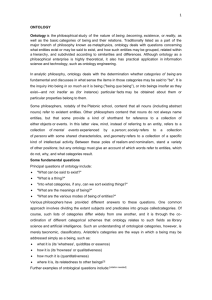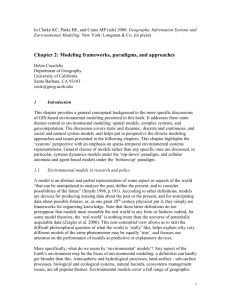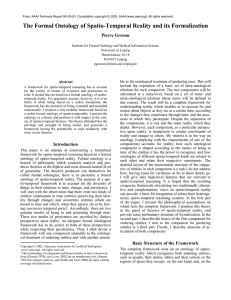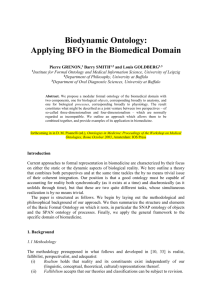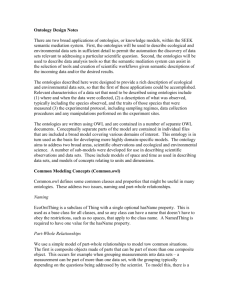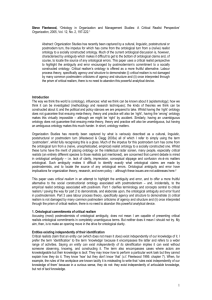BFO/MedO: - Buffalo Ontology Site
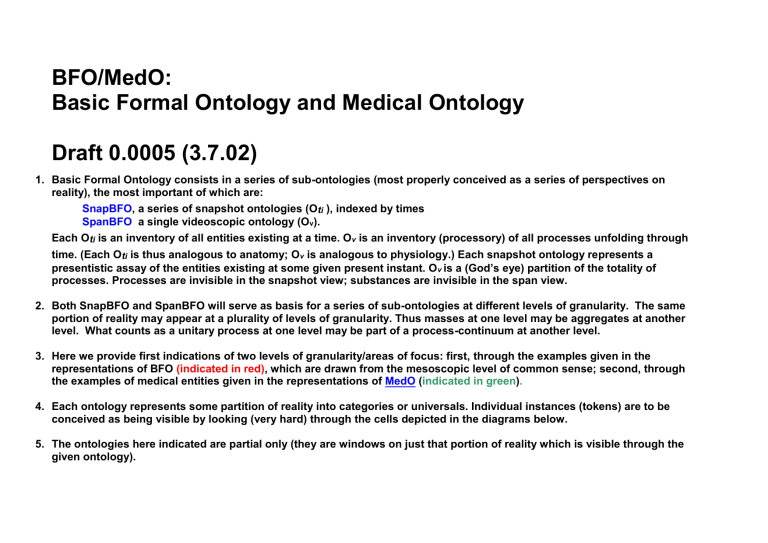
BFO/MedO:
Basic Formal Ontology and Medical Ontology
Draft 0.0005 (3.7.02)
1. Basic Formal Ontology consists in a series of sub-ontologies (most properly conceived as a series of perspectives on reality), the most important of which are:
SnapBFO , a series of snapshot ontologies (O t i
), indexed by times
SpanBFO a single videoscopic ontology (O v
).
Each O t i
is an inventory of all entities existing at a time. O v
is an inventory (processory) of all processes unfolding through time. (Each O t i
is thus analogous to anatomy; O v
is analogous to physiology.) Each snapshot ontology represents a presentistic assay of the entities existing at some given present instant. O v is a (God’s eye) partition of the totality of processes. Processes are invisible in the snapshot view; substances are invisible in the span view.
2. Both SnapBFO and SpanBFO will serve as basis for a series of sub-ontologies at different levels of granularity. The same portion of reality may appear at a plurality of levels of granularity. Thus masses at one level may be aggregates at another level. What counts as a unitary process at one level may be part of a process-continuum at another level.
3. Here we provide first indications of two levels of granularity/areas of focus: first, through the examples given in the representations of BFO (indicated in red) , which are drawn from the mesoscopic level of common sense; second, through the examples of medical entities given in the representations of MedO ( indicated in green ) .
4. Each ontology represents some partition of reality into categories or universals. Individual instances (tokens) are to be
5. The ontologies here indicated are partial only (they are windows on just that portion of reality which is visible through the given ontology). conceived as being visible by looking (very hard) through the cells depicted in the diagrams below.
6. A cell labeled
*
within a given ontology represents a category division which involves some double-counting in relation to the categories within the same ontology represented by cells not so labeled.
7. The spatial regions acknowledged by SnapBFO are, on the mesoscopic level of granularity, the sorts of domesticated spatial regions referred to by exp ressions such as ‘in the room’, ‘in the lung’, ‘on the table’, ‘in Poland’ etc. (Thus they are not the abstract spatial regions investigated by physics.) Free portions of space are spatial regions of the same time but with no physical boundaries or retainers (such as walls, floor, ceiling). Bound portions of space can be bound either completely, as in the case of a closed room or an air-bubble inside your body, or partially, as in the case of a birdcage or nostril. Free and bound portions of space retain their identity from one instant to the next even though they are projected in succession onto distinct abstract spatial regions in the physicist’s sense (just as substances retain their identity from one instant to the next even though they are projected in succession on distinct aggregates of molecules).
8. The spatiotemporal regions acknowledged by SpanBFO are similarly regions determined by domesticated portions of space over (for example) clock or calendar time. They are the spatiotemporal regions occupied by behavior settings in Roger
Barker’s sense (the 5pm train to Long Island, the early morning swim, your meeting with the Dean): http://ontology.buffalo.edu/socobj.htm.
9. Where substances fall within the natural world of constant causal change, a quasi-substance such as a chess club belongs to the realm of social-political-administrative entities and changes only as a result of administrative acts such as the admission of a new member. Where qualities, similarly, fall within the natural world of constant causal change, a quasiquality such as a debt or a rank belongs to the realm of social-political-administrative entities and changes only as a result of administrative acts such as a payment or a waiving of the debt. All roles are quasi-entities (entities not subject to constant causal-energetic changes).
10. Dependent entities, both within the SNAP and within the SPAN ontologies, are divided into relational (for entities dependent on a plurality of entities) and non-relational (for entities dependent on a single entity).
SnapBFO (Ontologies O
ti
indexed by time instants)
Enduring Entity
[Exists in space and time, has no temporal parts]
Spatial Region of Dimension 0,1,2,3
Free Portion of Space
Air traffic corridor
Physically Bound Portion of Space
Stationary
Room, Porch
Hole, Niche, Place
Mobile
Cockpit, Hull
Dependent Entity
[±Relational]
Independent Entities and Their Parts and Aggregates
Quality, State, Power
[Sometimes form Quality Regions or Scales]
The ball’s redness, The cat’s being on the mat, The iron bar’s magnetism,
Substance
[maximally connected causal unity]
Human being, Cat, Lump of cheese
Aggregate of Substances *
Family, Portion of rice, Bikini Quasi-Quality, Quasi-State, Quasi-Power
Plan, Algorithm, Price, Debt, Contract, State of being married, Role of vicar,
Functions of the President
Fiat Part of Substance *
Handle, tail, mountain
Boundary of Substance *
Fiat or Bona Fide or Mixed
Quasi-Substance
Chess club, College, Corporation
SpanBFO (Videoscopic Ontology O
v
)
Concrete Entity
[Exists in space and time, unfolds in time phase by phase]
Processual Entity
[normally dependent on substances and thus
±Relational]
Process
Exercise of role, function, power
Aggregate of Processes*
Fiat Part of Process*
Instantaneous Temporal Boundary of Process
(= Ingarden’s 'Event’)*
Quasi-Process
Increase in the interest rate
Spatio-Temporal Region of Dimension T, T+0, T+1, T+2, T+3
Region occupied by a process such as a chess match


